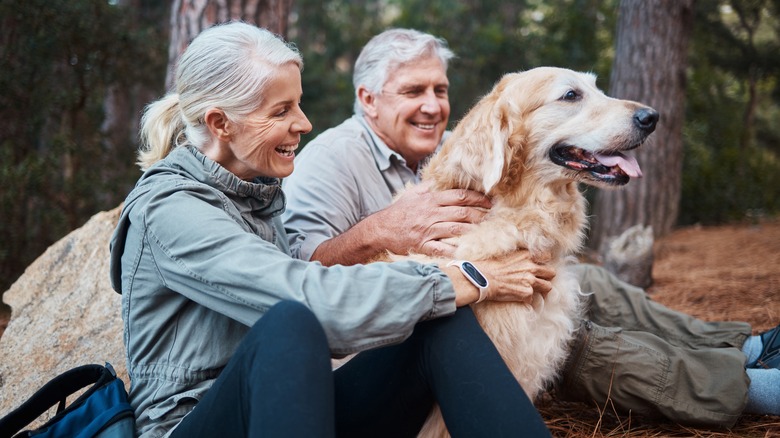There’s no better way to hike than with your furry best friend by your side. However, being a responsible dog owner means cleaning up after them and disposing of their poop properly. While most hiking trails have trash cans or designated areas for pet waste, sometimes you may find yourself on a trail without facilities.
Using biodegradable poop bags is a no-brainer and one of the most eco-friendly ways to dispose of your dog’s waste. These bags are specially designed to break down quickly, leaving no harmful impacts on the environment. However, you won’t want to throw the bag on the ground, as other hikers may come across it, or animals might get to it. Carrying the bags can be cumbersome and unsanitary, but putting them in your pack is not exactly the best option either. So, what do you do?
Portable containers are an ideal solution for carrying your dog’s waste. Leak-proof containers come in various sizes and can be attached to your backpack or leash, making it a hassle-free option. If you forgot a container and need a solution mid-way through a trail, don’t fret. There are plenty of creative ways to handle the situation.
Bury waste in permitted areas
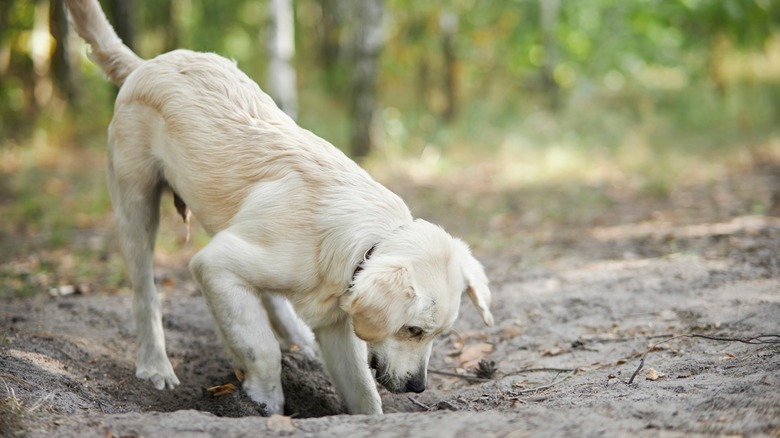
In areas where regulations permit, consider burying your dog’s waste in a “cathole” at least 6 to 8 inches deep. This method follows Leave No Trace principles, allowing the waste to decompose naturally. When left on the surface, dog poop can potentially transmit harmful bacteria and parasites to other animals or even humans. By burying it (appropriately), you are minimizing this risk.
Ensure you’re at least 200 feet away from water sources to prevent contamination. However, be aware of local guidelines and restrictions regarding waste disposal, as some regions may have specific regulations. In some areas, burying waste may not be feasible due to restrictions or lack of proper soil conditions.
In these cases, it’s important to always carry out your dog’s waste with you and properly dispose of it in designated trash receptacles. Never leave poop bags on the trail or attempt to bury them in inappropriate areas, like near campsites or water sources. If you are unable to bury it, don’t worry. Your pup may be the key to saving you the hassle (and smell) of carrying their waste…
Let your pup carry their own bags
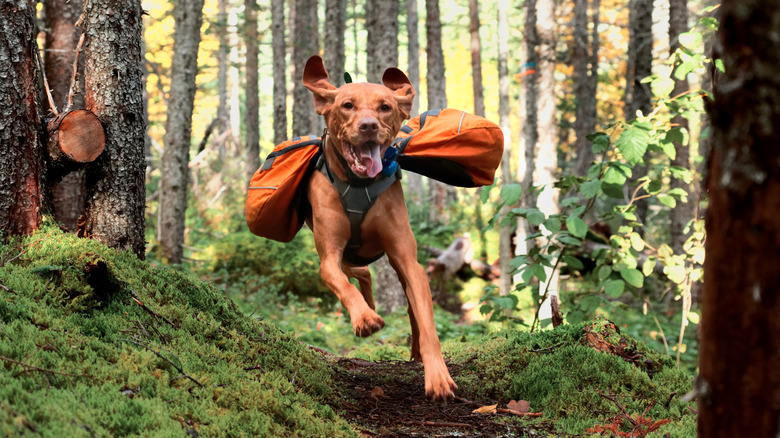
Turn your canine companion into a helpful hiking buddy by having them carry their own poop bags. Some harnesses and backpacks are specifically designed for dogs to carry their own supplies, including waste. Attaching a bag or container to their harness or backpack will ensure they carry their waste while on the trail.
Looping a bag onto a normal harness and tying it securely may also work for dogs not used to wearing a larger harness meant for supplies. This might not be as secure, but it can still act as a more sanitary option and make the hike more enjoyable. Simply tie the bag to a loop on your dog’s harness and dispose of it properly once you reach a designated trash receptacle, or cleverly clip it under your vehicle’s back wiper for a short drive to dispose of it at home. Though double bagging it and dealing with the potential smell is the easiest, most common solution. It’s just not as creative!
If your pup doesn’t use a harness, use their leash as a makeshift carrier. Tie or attach the bag to the leash using a clip or carabiner. Most poop bag dispensers are equipped with a carabiner to attach to your dog’s leash; but in the event your bags aren’t stored this way, you can tie the bag around the handle of the leash. It is not an ideal long-term solution, but this method will prevent you from carrying the bag directly.
Purchase a fancy poop holder
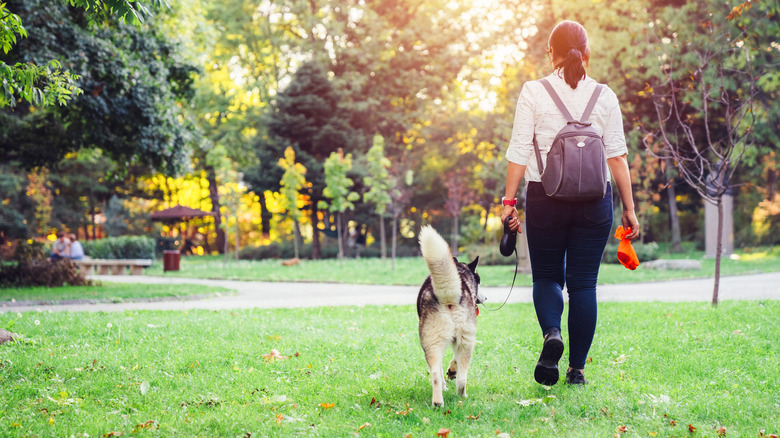
Martin-dm/Getty Images
If you’ve run into this issue on a trail before and have had to resort to carrying a bag of dog waste, you’ve likely looked for a solution for next time. One of the best options on the market is a holder made specifically for this purpose. Chewy sells the “Dog Doo Tube,” a holder that attaches to your pup’s leash, which holds one or multiple bags at once, depending on size. These containers have features for odor control, easy disposal, and clip-on options for your dog’s harness or leash.
Another option is a hands-free carrier such as the “PoopPac,” which can hold dog waste and other items such as keys, cell phones, and wallets (in a separate compartment, of course). Larger pack-out bags are available for long hikes or multi-dog households. These carriers can be easily attached to a leash or worn around the waist, allowing you to keep your hands free and avoid carrying bags of dog waste in hand.
For backpackers, some models attach securely to their backpacks. These containers are designed to be more breathable and lightweight since they aren’t worn on your body or your pup’s harness. Lightweight and durable options won’t add much bulk to your hiking gear but still give you an easy and sanitary way to carry dog waste while hiking. Though these tools aren’t incredibly expensive, some more frugal pet owners might decide to opt for a DIY solution.
Use an old jar or container
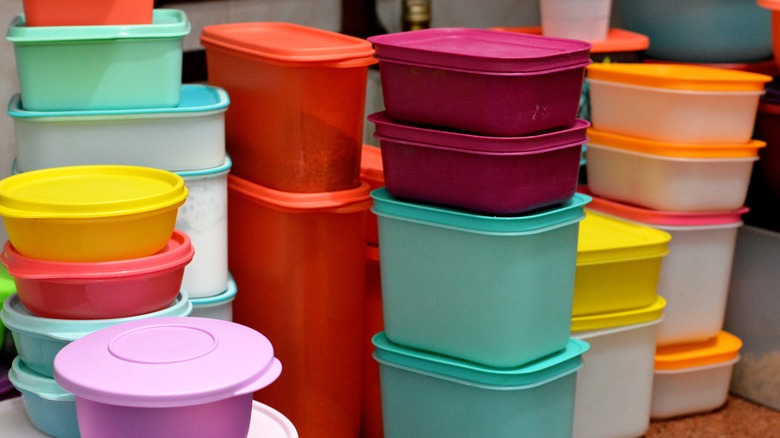
Tamer A Soliman/Shutterstock
Airtight plastic bags or even old food containers can serve as temporary solutions for carrying your dog’s waste until you can properly dispose of it. Peanut butter jars or coffee cans with secure lids are also great, cost-effective options. Though most containers are sealed, waterproof your backpack for added protection from the elements and potential leakage, and label the container clearly so you don’t accidentally mistake it for something else.
Putting a small amount of kitty litter or baking soda in the container can help absorb any odors and make the waste easier to handle. The container can easily slip into your pack without taking up much space or adding extra weight. If you don’t have any containers to use, try using old grocery bags or plastic bags from stores. Just be mindful of their environmental impact. This type of bag can take years to decompose and harm wildlife without proper use and disposal.
Sandwich bags are an okay alternative, as they are durable and can be reused multiple times, even allowing for washing in between uses. Just make sure to properly dispose of them once they have reached the end of their lifespan. Add a dryer sheet to a ziplock bag containing your dog’s waste. Not only does this mask the smell effectively, but it also prevents your backpack or pocket from absorbing any unpleasant odors. A simple yet effective trick to enhance your hiking experience.
Use a lined PVC pipe
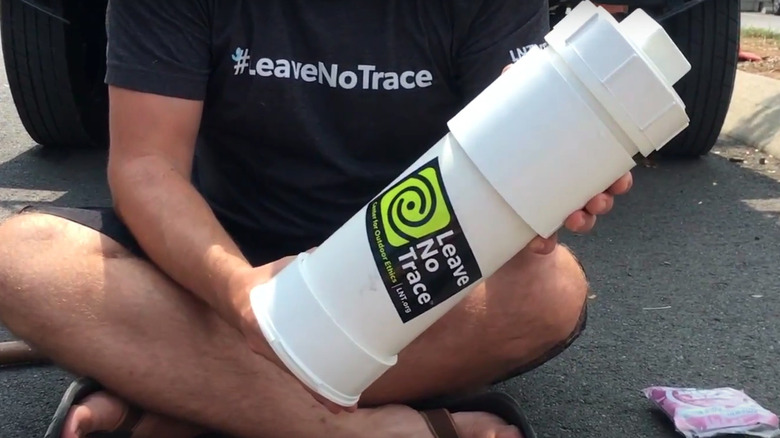
Leave No Trace Center for Outdoor Ethics/Youtube
A more durable DIY solution for carrying your dog’s waste is using a lined PVC pipe. Purchase a large PVC pipe and place a cap on one end and an easily openable end on the other. Cut the pipe to the desired length and line it with a plastic bag, leaving some extra hanging over the edges. This will serve as a barrier between the inside of the pipe and your dog’s waste.
Some hikers have gone the extra mile and attached it to the side of a backpack using tied or glued-on straps; but with the proper seal, the pipe can fit safely into your bag. Whenever your dog does their business, simply scoop it up, open the pipe, place the waste inside, and replace the cap. The plastic bag lining will prevent any mess or unpleasant odors from escaping and give you a simple way to remove the contents for disposal.
Once you’ve reached a designated waste disposal area, simply open the cap and remove the bag to dispose of your dog’s poop, then replace it with a new liner. This method is perfect for longer backcountry hikes where you may not have access to waste disposal facilities for longer periods of time. It also keeps the waste away from your supplies and food, ensuring they remain clean and safe.

